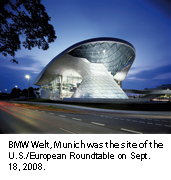
|
|
|
 |
|
 |
Global Mindset, Virtual Organization: The Changing Nature of Corporations Roundtable on Digital Strategies September 18, 2008 hosted by BMW CIOs and other senior execs from BMW, Bechtel, IBM, Nestle, BT, Holcim Group, Hilti and academics from Tuck, INSEAD and London Business School, participated in this roundtable. |
||
|
Agenda
List of Participants Overview Article
| |||||
The landscape of the corporation is steadily changing. Firms, with their ever-expanding global footprint, face new challenges in managing far-flung and diverse partners and customers. The explosion of communication capabilities has empowered a new generation of employees and leaders who are operating in this new, more virtual circumstance—and these steady changes continue to rock traditional operating models. This is particularly true in an information technology environment where traditional, vertical ways of working are being broken down and an ecosystem is emerging where customers, competitors, and suppliers all collaborate much more closely than in the past.
This new way of working is requiring us to think differently about how we manage our people, how we work across boundaries and cultures, how we express our values, and how we approach IP. It is forcing different ways of working with our customers (including greater levels of autonomy and self-service in some instances) and with our competitors, and encouraging new forms of open innovation and development that are likely to have significant implications for all of our organizations.
In this roundtable, we examined how these changes impact the existing organizational paradigms, values and mindsets.
We examined questions including:
- What is the appropriate organizational structure for a global corporation today? How dependent is this on industry?
- Is the balance between centralization and decentralization/localization changing as a result of many of the trends/phenomena outlined above?
- What functions or areas are important to be truly global? Are there others where a “multi-regional” or even a local approach is better? Do philosophies like “global branding, local marketing” still hold true?
- What are the implications for organizations of the trends towards virtualization of all flavors? In particular, what does it mean for IT?
- How do we enable the appropriate amount of collaboration, both internally and externally, to take advantage of its potential and address the needs of a new generation of employees and customers, yet appropriately protect a corporation’s information assets and IP?
- What are the challenges of aligning a workforce to a corporate operating model—or does it have to be the other way around given the location of various talent pools? What’s the right balance, what are the tradeoffs?
- What have we learned about recruiting, retaining and managing talent in today’s environment? What are the keys to managing a truly global workforce? How do you get the right people in the right place at the right time?
- What progress have we made in building cross-cultural understanding that allows better communication and coordination around the globe? Are firms investing appropriately in building these “soft skills” needed for a global mindset?
![]()
| M&A and Divestitures: Integration and Disintegration (U.S. Roundtable) - Thought Leadership Roundtable on Digital Strategies | |
| Strategic Partnering: Managing Joint Ventures and Alliances - Thought Leadership Roundtable on Digital Strategies | |
| The CIO as Strategic Business Partner: Leading Change and Driving Results - An Executive Workshop | |